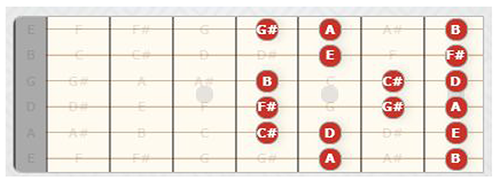JP BLOG
Share this
When you’re beginning to learn how to play guitar, it’s a good idea to get a basic grasp of music theory. You don’t have to know everything to be a good player, but knowing some will help you to make more informed choices of the notes and chords you play.
Music theory is really the art of determining what notes sound good together. You could, theoretically, put your fingers on the fretboard and play any random grouping of notes together, but the sound that resulted probably wouldn’t sound very pleasing to the ears. Instead, there’s an underlying system that musical notes adhere to. Some notes sound good together; some don’t.
Starting With the Major Scale
The foundation of all music is the major scale, which will be the focus of this post. Specifically, we’ll be focusing on how to build any major scale because there’s a definitive pattern to the notes in that scale.
Before we look at the pattern, however, you need to first understand all of the notes that are available to you. Music notes use the following letter names.
- A B C D E F G
But some of the letters have notes in between them, denoted by either a sharp (#), which means the note is higher than the note letter name, or a flat (b), which means the note is lower than the note letter name. For example, there is a note between A and B, which can be called A#, which means that it’s a half step above A, or Bb, which means that it’s a half step below B.
The complete list of note names is below.
| A | A#/Bb | B | C | C#/Db | D | D#/Eb | E | F | F#/Gb | G | G#/Ab |
As you can see, there are a total of 12 notes from which you can build musical scales. Major scales, however, only use 7 of those notes plus the octave above the root note. An octave just means that the note is the same as the root note, just higher in pitch. A high A, then the next higher A, for instance. Same note, just higher in pitch.
Between each note is a half step, so A to A# is a half step. Two half steps is a whole step, so A to B would be a whole step.
The Pattern of the Major Scale
The pattern of half steps and whole steps to build a major scale is: W W H W W W H (whole, whole, half, whole, whole, whole, half). On the fretboard, you can think of each fret as one half step apart. For example, the first and second fret are a half step apart, but the first to the third fret would be a whole step apart.
Start on any note in the 12-note scale above and use the pattern to create any major scale. If you start with the note A and follow the pattern you end up with the major scale in the diagram below.
Likewise, on the fretboard, if you start on any note, you can follow the pattern of half steps (1 fret) and whole steps (2 frets) to create a major scale, as in the diagram below.
Of course, when you’re playing scales, you won’t play them just on one string. Instead, you’ll play them across the fretboard, often in a box pattern, like in the diagram below.
You can move this box pattern up and down the fretboard starting on any note on the sixth string to play any major scale.
You can play the scale up and down or play notes within the scale to create melodies that have a major sound to them. Next time, we’ll look at how to combine notes in the major scale that sound good together to create chords.
Join the more than 500,000 guitarists who have experienced JamPlay. Guitar lessons from world class instructor artists in every genre and for every interest to power up your guitar skill. Become a member today at JamPlay.com.




